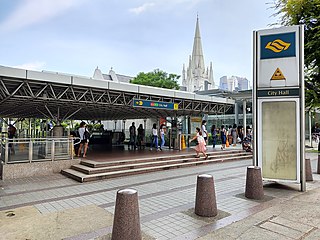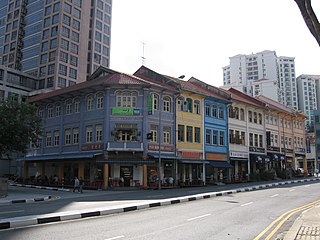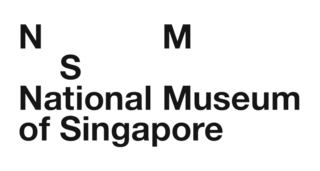
City Hall MRT station is an underground Singapore Mass Rapid Transit (MRT) interchange station on the North–South line (NSL) and East–West line (EWL). Situated in the Downtown Core district, it is underneath Stamford Road near the road junctions with North Bridge Road and St Andrew's Road. The station is near landmarks such as the former City Hall, Raffles City, the Padang, St Andrew's Cathedral and the Cenotaph.

Raffles Place MRT station is an underground Mass Rapid Transit (MRT) interchange station on the North South Line (NSL) and East West Line (EWL) in Singapore. Located in the Downtown Core, the station is underneath Raffles Place south of the Singapore River. The station serves various landmarks including The Fullerton Hotel, Merlion Park and the Asian Civilisations Museum and various commercial buildings such as One Raffles Place and OCBC Centre.

The Singapore River is a river that flows parallel to Alexandra Road and feeds into the Marina Reservoir in the southern part of Singapore. The immediate upper watershed of the Singapore River is known as the Singapore River Planning Area, although the western part of the watershed is classified under the River Valley planning area.
National monuments of Singapore are sites, buildings and structures in Singapore that have been designated by the National Heritage Board (NHB) as being of special historic, traditional, archaeological, architectural or artistic value. For historical significance, these buildings are not allowed to be demolished. The Preservation of Monuments Act gives the board authority to order the preservation of such sites and promote research and public interest in the monuments.

The Padang is an open playing field located within the Downtown Core of the Central Area in Singapore. It includes the Padang Cricket Ground. The Padang is surrounded by several important landmarks, which include Saint Andrew's Cathedral, City Hall, the Old Supreme Court Building and the City Hall MRT station.

Boat Quay is a historical quay in Singapore which is situated upstream from the mouth of the Singapore River on its southern bank. It spans from the shophouses near UOB Plaza, stretching along one bank of the Singapore River, all the way till Elgin Bridge.

Elgin Bridge is a vehicular box girder bridge across the Singapore River, linking the Downtown Core to the Singapore River Planning Area located within Singapore's Central Area. It was built between 1925 and 1929.

Anderson Bridge is a pedestrian bridge that spans across the Singapore River. It is located near the river's mouth in the Downtown Core Planning Area of Singapore's Central Area.

Lau Pa Sat, also known as Telok Ayer Market, is a historic building located within the Downtown Core in the Central Area of Singapore. It was first built in 1824 as a fish market on the waterfront serving the people of early colonial Singapore and rebuilt in 1838. It was then relocated and rebuilt at the present location in 1894. It is currently a food court with stalls selling a variety of local cuisine.

River Valley is a planning area located within the Central Area of the Central Region of Singapore. The planning area shares boundaries with Orchard in the north, Museum in the east, Tanglin in the west and Singapore River in the south.

The Chesed-El Synagogue is a synagogue in Singapore. The synagogue was constructed in 1905 and is located at Oxley Rise in River Valley, within the Central Area of Singapore.

The National Museum of Singapore is a public museum dedicated to Singaporean art, culture and history. Located within the country's Civic District at the Downtown Core area, it is the oldest museum in the country. It is one of the largest museums in Asia.

The Memorial to the Civilian Victims of the Japanese Occupation, usually called the Civilian War Memorial, is a war memorial and heritage landmark in Singapore next to Esplanade MRT station. It was built in memory of the civilians killed during the Japanese occupation of Singapore during World War II. The Civilian War Memorial sits on serene parkland in the midst of busy city traffic near Singapore's Padang and City Hall. Located within the War Memorial Park at Beach Road within the Central Area, Singapore's central business district, it is usually easy to spot in most backdrops encompassing the CBD landscape. It was gazetted as the 65th national memorial on 15 August 2013.

Tan Kim Seng, was a prominent Straits-born Chinese merchant and philanthropist in Singapore in the 19th century.

Connaught Drive is a one-way road linking Stamford Road to Fullerton Road on the northern side of the Singapore River within the Downtown Core in Singapore. Esplanade Park is on the left side of the road, and The Padang is on the right. Before the Esplanade Bridge was opened in 1997, the road was used by vehicles from Marina Centre and Nicoll Highway to cross the Singapore River. The road is still used by several bus services and as a car park on both sides of the road as well as for coach parking.

The Museum Planning Area is a planning area located in the Central Area of the Central Region of Singapore. The area plays a "bridging role" between the Orchard area and the Downtown Core, which necessitates proper transport networks for vehicles, pedestrians and public transport. Due to the sheer size of green areas in the district, the Urban Redevelopment Authority (URA) has designated it a 'green lung' in the Central Area. However, the Museum Planning Area is also home to cultural and commercial activities. Around 65% of the area is available for future development, making it a hotbed for new infrastructure and buildings.

The Fullerton Hotel Singapore is a five-star luxury hotel located near the mouth of the Singapore River, in the Downtown Core of the Central Area, Singapore. It was originally known as the Fullerton Building, and also as the General Post Office Building. The address is 1 Fullerton Square. The Fullerton Building was named after Robert Fullerton, the first Governor of the Straits Settlements (1826–1829). Commissioned in 1924 as part of the British colony's centennial celebrations, the building was designed as an office building by Major P.H. Keys of Keys & Dowdeswell, a Shanghai firm of architects, which won the project through an architectural design competition. The architectural firm also designed the Capitol Theatre, its adjoined Capitol Building and the Singapore General Hospital. In 2015, it was designated as a national monument of Singapore.

The Tan Kim Seng Fountain is a fountain in Singapore that was erected in 1882 in honor of notable philanthropist Tan Kim Seng for his donations for the Singapore's first reservoir and waterworks.






















